Mt. Washington via Lion Head
February 6, 1999
Hikers: Scott Fitzgerald, Rebecca Williams, Tarjei Mikkelson,
Hector Briceno, Matthew Reagan, Robert Zeithammer, Michelle Berris,
Parul Vakani (MITOC Winter School '99).
This is a hike I'd been wanting to do for a very long
time--Mt. Washington in the dead of winter! Fortunately a mild winter
made for a surprisingly reasonable climb, if 4,200' and 10 miles is
ever "reasonable."
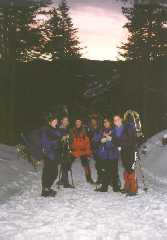 After a mere three hours of sleep in the MITOC
Intervale Cabin, our intrepid eight awoke at 3am in hopes of an early
start. After breakfast, driving, and re-packing, weighing, and
complaining (except for Hector, who proudly shouldered his enormous
pack), we still didn't hit the trail until 5:45am, but all things
considered, that's still not too bad! With our altimeter and GPS
calibrated to document our efforts, we headed up the Tuckerman Ravine
trail in the clear, moonlit pre-dawn hour, skipping the headlamps in
favor of the surreal grey glow of the snow-covered woods. After a
short time on the trail, the glow in the eastern sky overcame the moon
and stars as the sun rose behind the Carter-Wildcat range (right).
After a mere three hours of sleep in the MITOC
Intervale Cabin, our intrepid eight awoke at 3am in hopes of an early
start. After breakfast, driving, and re-packing, weighing, and
complaining (except for Hector, who proudly shouldered his enormous
pack), we still didn't hit the trail until 5:45am, but all things
considered, that's still not too bad! With our altimeter and GPS
calibrated to document our efforts, we headed up the Tuckerman Ravine
trail in the clear, moonlit pre-dawn hour, skipping the headlamps in
favor of the surreal grey glow of the snow-covered woods. After a
short time on the trail, the glow in the eastern sky overcame the moon
and stars as the sun rose behind the Carter-Wildcat range (right). 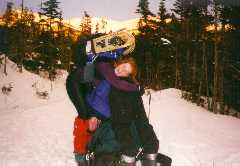 Despite being a little bleary-eyed from lack of REM
sleep, everyone was in good spirits, undoubtably buoyed by the sight
of the morning sun illuminating the snowfields on Mt. Washington and
Huntington Ravine (left).
Despite being a little bleary-eyed from lack of REM
sleep, everyone was in good spirits, undoubtably buoyed by the sight
of the morning sun illuminating the snowfields on Mt. Washington and
Huntington Ravine (left).
After three or so miles on the wide, gradual, groomed Tuck's trail, we
found the detour signs for the Lion Head Winter Route. This trail,
closed to summer use due to severe erosion, provides a steep but
sheltered ascent of the ridge that forms the northern boundary of
Tuckerman Ravine. After a few hundred yards in the woods, the
climbing began in earnest, and we faced our first real challenge. The
alternating freeze-thaw cycle of the past month had coated the rocks
and exposed roots with a thick layer of water ice, which was then
topped by a few inches of soft snow and a crunchy crust. Crampons
became essential, and (for me) stiffer boots would have been nice,
too. Some sections were nearly technical, requiring creative use of
an ice ax and tree roots to keep moving upward.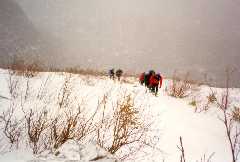 Loss of footing resulted in rapid downward
acceleration, requiring good self-arrest technique. As we gained
altitude, light snow began to fall, and the blue sky became
increasingly obscured by a dark cloud that oozed down from the
summit.
Loss of footing resulted in rapid downward
acceleration, requiring good self-arrest technique. As we gained
altitude, light snow began to fall, and the blue sky became
increasingly obscured by a dark cloud that oozed down from the
summit.
We broke out of the trees to a wonderful view of Pinkham Notch below
and Wildcat Mtn. across the valley. We stopped near treeline to eat,
drink, and add wind gear, and headed up the exposed ridge (right). We
soon met some more characteristic Presidential weather, particularly
that gusty wind that seems to slap you around rather than simply push
you over. 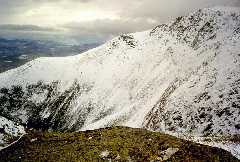 Clouds blew down from the
Alpine Garden, but occasional clear patches gave excellent views
across Tuckerman Ravine toward Boott Spur (left). The ravine itself
remained obscured in its own little fogbank, but patches of blue and
brown indicated that skiing would be sparse this year unless some big
storms took up the slack.
Clouds blew down from the
Alpine Garden, but occasional clear patches gave excellent views
across Tuckerman Ravine toward Boott Spur (left). The ravine itself
remained obscured in its own little fogbank, but patches of blue and
brown indicated that skiing would be sparse this year unless some big
storms took up the slack.
The grade lessened as Lion Head blended into the main mass of the
mountain. We soon reached the junction with the Alpine Garden trail,
then climbed across the base of the summit cone to meet the upper
Tuckerman Ravine trail just above the Headwall. As thick fog moved in
and the wind shifted to a steady SW gale, we began ascending the
summit snowfields (right). 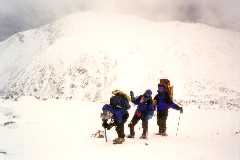 At this point we had
been climbing for nearly five hours, and the whole enterprise just
didn't seem all that much fun anymore! The snowfields would have made
a perfect, consistent, skiable pitch, but we zig-zagged across the
snow and wind-scoured ice to stay on the beaten path and to keep our
crampons firmly planted.
At this point we had
been climbing for nearly five hours, and the whole enterprise just
didn't seem all that much fun anymore! The snowfields would have made
a perfect, consistent, skiable pitch, but we zig-zagged across the
snow and wind-scoured ice to stay on the beaten path and to keep our
crampons firmly planted.
It was tiring work, and the lack of visibility made this rather short
climb seem endless. At the last trail junction, we decided to press
on despite being a little behind schedule--the relatively "warm"
temperatures (low 20s) made this seem like a reasonable decision
despite the wind and fog. 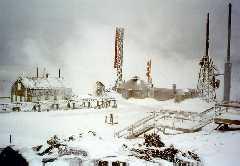 After a long, slow,
somewhat painful slog, we finally encountered the Auto Road, the upper
parking lot, and finally the Cog Railroad tracks, from where we had a
great view of the summit complex (left). A surprising number of
people were milling around up top--some had been ascending with us,
while others apparently had taken a short cut directly up from the
Alpine Garden.
After a long, slow,
somewhat painful slog, we finally encountered the Auto Road, the upper
parking lot, and finally the Cog Railroad tracks, from where we had a
great view of the summit complex (left). A surprising number of
people were milling around up top--some had been ascending with us,
while others apparently had taken a short cut directly up from the
Alpine Garden. 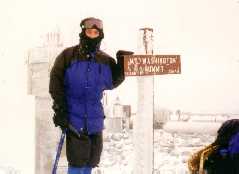 Either way, it made this
remote place seem far less forbidding.
Either way, it made this
remote place seem far less forbidding.
After all that work, I finally got a picture of myself on the summit
in winter (right). Of course, I probably could have gotten by without
the balaclava and goggles, but I figured I wanted to make it look just
a little more impressive.
As one person after another made the last climb to the actual summit,
the clouds even began to clear! As we huddled in the sheltered
walkway of the main summit building, clear views opened up toward the
north (left) 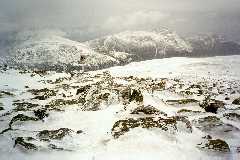 giving a fine shot of
Jefferson, Adams, and Madison across the icy wastes of the alpine
zone. We stuffed ourselves with all the fat, sugar, and water we
could handle, added a few extra layers to fight off the dropping
temperatures, and prepared for a speedy descent.
giving a fine shot of
Jefferson, Adams, and Madison across the icy wastes of the alpine
zone. We stuffed ourselves with all the fat, sugar, and water we
could handle, added a few extra layers to fight off the dropping
temperatures, and prepared for a speedy descent.
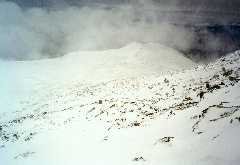 Our descent down the cone gave us views that had been
obscured by the fog just an hour before, including the Southern
Presidentials (right) across Monroe Flats. We dropped altitude
quickly, assisted by excellent glissading conditions on the
snowfields, and we reached treeline at the top of Lion Head rather
quickly. Once again, the wind picked up on the ridge, and as the
temperature began to drop rapidly, we appreciated what "nice"
conditions we had experienced earlier in the day. Once in the trees,
we had a wild ride down the slick and snowy Lion Head trail, with only
occasional snags on hidden roots and a few minor crampon problems.
Our descent down the cone gave us views that had been
obscured by the fog just an hour before, including the Southern
Presidentials (right) across Monroe Flats. We dropped altitude
quickly, assisted by excellent glissading conditions on the
snowfields, and we reached treeline at the top of Lion Head rather
quickly. Once again, the wind picked up on the ridge, and as the
temperature began to drop rapidly, we appreciated what "nice"
conditions we had experienced earlier in the day. Once in the trees,
we had a wild ride down the slick and snowy Lion Head trail, with only
occasional snags on hidden roots and a few minor crampon problems.
The walk down the Tucks trail seemed trivial in comparision, and by
the time we reached Pinkham Notch, food, beer, and sleep were all that
concerned us. We got all three as quickly as humanly possible.
photos by Matthew Reagan
Back to Outdoor
Adventures
 After a mere three hours of sleep in the MITOC
Intervale Cabin, our intrepid eight awoke at 3am in hopes of an early
start. After breakfast, driving, and re-packing, weighing, and
complaining (except for Hector, who proudly shouldered his enormous
pack), we still didn't hit the trail until 5:45am, but all things
considered, that's still not too bad! With our altimeter and GPS
calibrated to document our efforts, we headed up the Tuckerman Ravine
trail in the clear, moonlit pre-dawn hour, skipping the headlamps in
favor of the surreal grey glow of the snow-covered woods. After a
short time on the trail, the glow in the eastern sky overcame the moon
and stars as the sun rose behind the Carter-Wildcat range (right).
After a mere three hours of sleep in the MITOC
Intervale Cabin, our intrepid eight awoke at 3am in hopes of an early
start. After breakfast, driving, and re-packing, weighing, and
complaining (except for Hector, who proudly shouldered his enormous
pack), we still didn't hit the trail until 5:45am, but all things
considered, that's still not too bad! With our altimeter and GPS
calibrated to document our efforts, we headed up the Tuckerman Ravine
trail in the clear, moonlit pre-dawn hour, skipping the headlamps in
favor of the surreal grey glow of the snow-covered woods. After a
short time on the trail, the glow in the eastern sky overcame the moon
and stars as the sun rose behind the Carter-Wildcat range (right).  Despite being a little bleary-eyed from lack of REM
sleep, everyone was in good spirits, undoubtably buoyed by the sight
of the morning sun illuminating the snowfields on Mt. Washington and
Huntington Ravine (left).
Despite being a little bleary-eyed from lack of REM
sleep, everyone was in good spirits, undoubtably buoyed by the sight
of the morning sun illuminating the snowfields on Mt. Washington and
Huntington Ravine (left).





